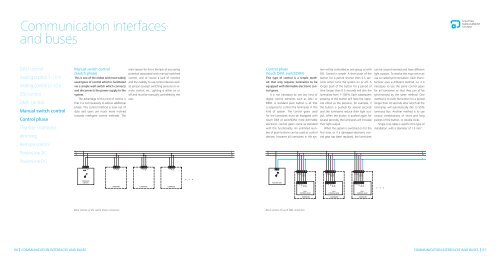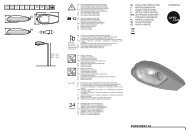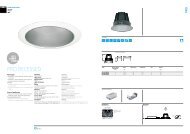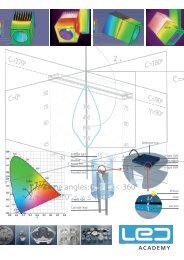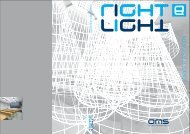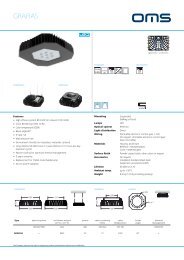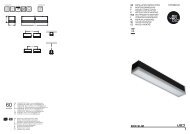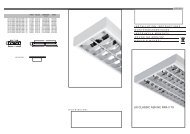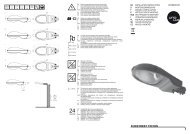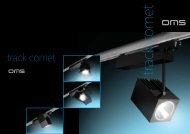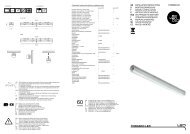Lighting MAnAgEMEnt SYStEM - OMS lighting
Lighting MAnAgEMEnt SYStEM - OMS lighting
Lighting MAnAgEMEnt SYStEM - OMS lighting
Create successful ePaper yourself
Turn your PDF publications into a flip-book with our unique Google optimized e-Paper software.
Communication interfaces<br />
and buses<br />
DALI control<br />
Analog control 1–10 V<br />
Analog control 0–10 V<br />
DSI control<br />
DMX control<br />
Manual switch control<br />
Control phase<br />
Thyristor / transistor<br />
dimming<br />
Manual switch control<br />
(Switch phase)<br />
This is one of the oldest and most widely<br />
used types of control which is facilitated<br />
via a simple wall switch which connects<br />
and disconnects the power supply to the<br />
system.<br />
The advantage of this kind of control is<br />
that it is not necessary to add an additional<br />
phase. This control method is now out of<br />
date and users are much more inclined<br />
towards intelligent control methods. The<br />
main reason for this is the lack of any saving<br />
potential associated with manual switched<br />
control, and of course a lack of comfort<br />
and the inability to use control devices such<br />
as sensors (except switching sensors) or remote<br />
control, etc. <strong>Lighting</strong> is either on or<br />
off and must be manually controlled by the<br />
user.<br />
Control phase<br />
(touch DIM, switchDIM)<br />
This type of control is a simple method<br />
that only requires luminaires to be<br />
equipped with dimmable electronic control<br />
gears.<br />
It is not necessary to use any kind of<br />
digital control elements such as DALI or<br />
DMX. A standard push button is all that<br />
is required to control the luminaires in this<br />
kind of system. The control gears used<br />
for the luminaires must be equipped with<br />
touch DIM or switchDIM; most dimmable<br />
electronic control gears come as standard<br />
with this functionality. An unlimited number<br />
of push buttons can be used as control<br />
devices, however all luminaires in the system<br />
will be controlled as one group as with<br />
DSI. Control is simple. A short push of the<br />
button for a period shorter than 0.5 seconds<br />
either turns the system on or off. A<br />
longer push of the button for a period of<br />
time longer than 0.5 seconds will dim the<br />
luminaires from 1–100 %. Each subsequent<br />
pressing of the button will have the opposite<br />
effect as the previous, for example, if<br />
the button is pushed for several seconds<br />
and the luminaires reduce their light output,<br />
when the button is pushed again for<br />
several seconds, the luminaires will increase<br />
their light output.<br />
When the system is switched on for the<br />
first time, or if a damaged electronic control<br />
gear has been replaced, the luminaires<br />
can be unsynchronised and have different<br />
light outputs. To resolve this issue we must<br />
use so-called synchronisation. Each manufacturer<br />
uses a different method, so it is<br />
necessary to use the same control gears<br />
for all luminaires so that they can all be<br />
synchronised by the same method. One<br />
method is to push the button for a period<br />
longer than 10 seconds after which all the<br />
luminaires will automatically dim to 50 %<br />
luminous flux. Another method is to use<br />
various combinations of short and long<br />
pushes of the button, or double clicks.<br />
Single core cable is used for this type of<br />
installation, with a diameter of 1.5 mm 2 .<br />
Remote control<br />
PowerLine AC<br />
PowerLine DC<br />
L<br />
N<br />
PE<br />
L<br />
N<br />
PE<br />
L‘<br />
L<br />
N<br />
PE<br />
L<br />
N<br />
PE<br />
L‘<br />
L<br />
N<br />
PE<br />
DA+<br />
DA–<br />
L<br />
N<br />
PE<br />
DA+<br />
DA–<br />
N<br />
L<br />
L‘<br />
L<br />
N<br />
PE<br />
L<br />
N<br />
PE<br />
L<br />
N<br />
PE<br />
STANDARD<br />
SWITCH<br />
PUSH BUTTON<br />
LUMINAIRE LUMINAIRE LUMINAIRE<br />
L<br />
N<br />
PE<br />
DA+<br />
DA–<br />
DALI<br />
CONTROL GEAR<br />
L<br />
N<br />
PE<br />
DA+<br />
DA–<br />
DALI<br />
CONTROL GEAR<br />
L<br />
L<br />
N<br />
PE<br />
DA+<br />
DA–<br />
N<br />
PE<br />
DA+<br />
DA–<br />
DALI<br />
CONTROL GEAR<br />
LUMINAIRE LUMINAIRE LUMINAIRE<br />
Block scheme of the switch phase connection<br />
Block scheme of touch DIM connection<br />
66 I Communication interfaces and buses<br />
Communication interfaces and buses I 67


